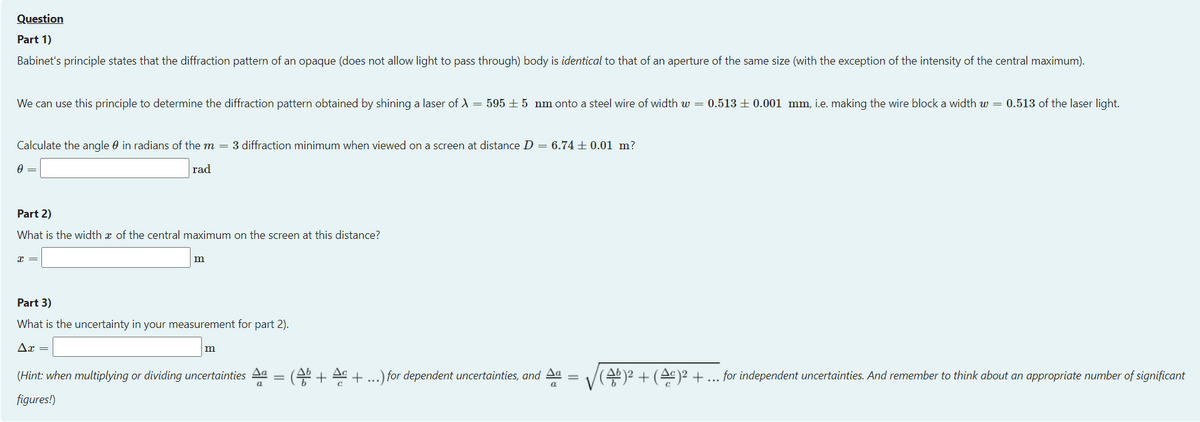Part 1) Babinet's principle states that the diffraction pattern of an opaque (does not allow light to pass through) body is identical to that of an aperture of the same size (with the exception of the intensity of the central maximum). We can use this principle to determine the diffraction pattern obtained by shining a laser of A = 595 + 5 nm onto a steel wire of width w = 0.513± 0.001 mm, i.e. making the wire block a width w = 0.513 of the laser light. Calculate the angle e in radians of the m = 3 diffraction minimum when viewed on a screen at distance D = 6.74± 0.01 m? rad
Part 1) Babinet's principle states that the diffraction pattern of an opaque (does not allow light to pass through) body is identical to that of an aperture of the same size (with the exception of the intensity of the central maximum). We can use this principle to determine the diffraction pattern obtained by shining a laser of A = 595 + 5 nm onto a steel wire of width w = 0.513± 0.001 mm, i.e. making the wire block a width w = 0.513 of the laser light. Calculate the angle e in radians of the m = 3 diffraction minimum when viewed on a screen at distance D = 6.74± 0.01 m? rad
Algebra & Trigonometry with Analytic Geometry
13th Edition
ISBN:9781133382119
Author:Swokowski
Publisher:Swokowski
Chapter7: Analytic Trigonometry
Section7.2: Trigonometric Equations
Problem 98E
Related questions
Question

Transcribed Image Text:Question
Part 1)
Babinet's principle states that the diffraction pattern of an opaque (does not allow light to pass through) body is identical to that of an aperture of the same size (with the exception of the intensity of the central maximum).
We can use this principle to determine the diffraction pattern obtained by shining a laser of A = 595 ± 5 nm onto a steel wire of width w = 0.513 ± 0.001 mm, i.e. making the wire block a width w = 0.513 of the laser light.
Calculate the angle 0 in radians of the m = 3 diffraction minimum when viewed on a screen at distance D = 6.74 ± 0.01 m?
rad
Part 2)
What is the width æ of the central maximum on the screen at this distance?
m
Part 3)
What is the uncertainty in your measurement for part 2).
Ax =
m
(Hint: when multiplying or dividing uncertainties Aa
(4 + A + ...) for dependent uncertainties, and Aa
(4b)2 + (As)2 +... for independent uncertainties. And remember to think about an appropriate number of significant
%3D
figures!)
Expert Solution
This question has been solved!
Explore an expertly crafted, step-by-step solution for a thorough understanding of key concepts.
This is a popular solution!
Trending now
This is a popular solution!
Step by step
Solved in 2 steps

Knowledge Booster
Learn more about
Need a deep-dive on the concept behind this application? Look no further. Learn more about this topic, advanced-math and related others by exploring similar questions and additional content below.Recommended textbooks for you

Algebra & Trigonometry with Analytic Geometry
Algebra
ISBN:
9781133382119
Author:
Swokowski
Publisher:
Cengage

Mathematics For Machine Technology
Advanced Math
ISBN:
9781337798310
Author:
Peterson, John.
Publisher:
Cengage Learning,

Algebra & Trigonometry with Analytic Geometry
Algebra
ISBN:
9781133382119
Author:
Swokowski
Publisher:
Cengage

Mathematics For Machine Technology
Advanced Math
ISBN:
9781337798310
Author:
Peterson, John.
Publisher:
Cengage Learning,